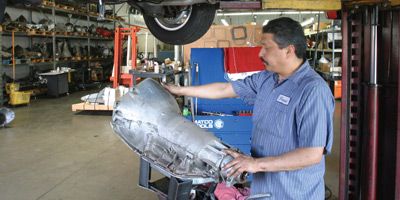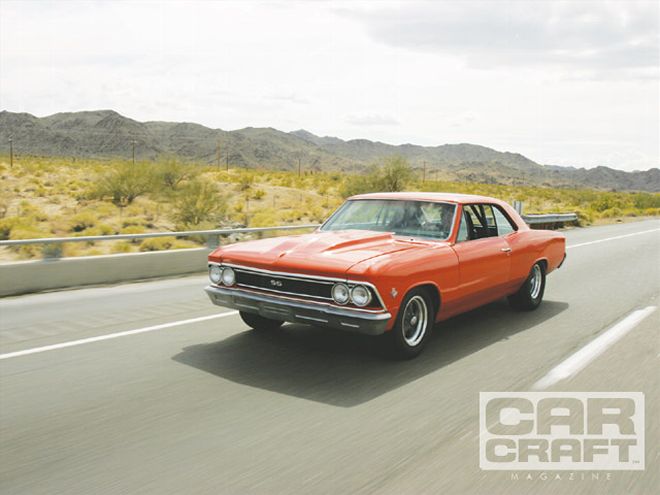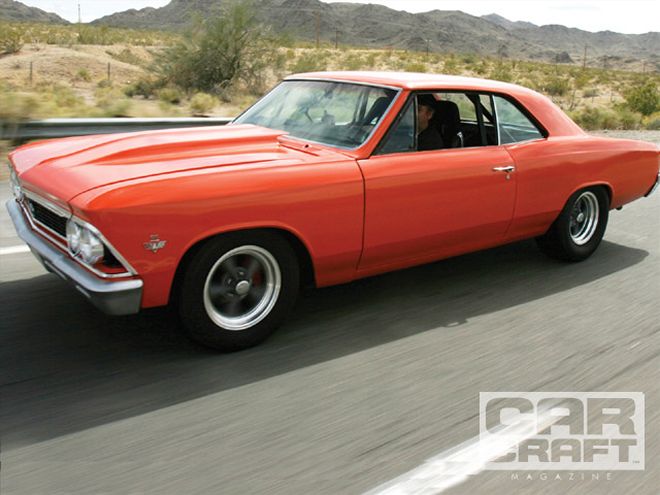
 It's amazing what a simple transmission swap will do to completely change a car's personality. The Chevelle went from a freeway-buzzy blunderer to a 900-mile road trip warrior.
It's amazing what a simple transmission swap will do to completely change a car's personality. The Chevelle went from a freeway-buzzy blunderer to a 900-mile road trip warrior.
Queen said it best: "I want it all, and I want it now!" The 21st century automotive version of immediate gratification stars our Orange Peel 383-urged '66 Chevelle as the underachieving street car. Sure it had high-11-second strip cred, but its freeway skills were lame. With a Turbo 400 three-speed auto and 3.55 gears, we were making lots of rpm and noise and getting nowhere slowly. We could have yanked the gear out of it, but that would have killed our 11-second dragstrip escapades. We wanted it all--to drastically reduce our freeway cruising rpm, improve the Chevelle's miserable single-digit fuel mileage, and run quicker at the digs. Sound impossible? Not really. The solution came in the form of a simple bolt-in silver bullet: a California Performance Transmission (CPT) 200-4R overdrive automatic.
Normally, we'd make you wade through the whole story for the results, but frankly our Chevelle's one-day gearbox swap was a home run. By just substituting a CPT 200-4R and a nonlockup 10-inch converter, the Chevelle transformed almost immediately. Our Buddha-belly "before" picture had the Chevelle screaming at 3,200 rpm at 70 mph. And even at that speed, we were in danger of being run over by Hyundais and the occasional aggressive left-wing Prius. The slim-and-trim "after" swap picture has our Orange Peel Chevelle as a kick-butt freeway flyer cruising effortlessly at 72 mph at 2,200 rpm. We took it to the dragstrip and on the first pass improved our eighth-mile times by 0.10 second with no other changes. Then we demon-tweaked the carb and on this year's Anti-Tour trip to Phoenix knocked down 14.3 mpg for 900 miles. There were some little tricks that made this whole effort possible, but the real story is that with a CPT overdrive trans, you really can have it all right now.
Why We Chose a 200-4R
Back in the Mar. '09 issue, we showed you why a 200-4R is an excellent choice for an overdrive automatic, as well as the modifications that California Performance Transmissions goes through to make these boxes even stronger. But there's more to the story. We started with one of CPT's performance transmissions treated to all the good mods. What makes the 200-4R such a great choice is that it will bolt right in place of a TH350, Powerglide, or, in our case, a TH400. The transmission case lengths do vary slightly between these transmissions, but even that's not a deal breaker. The important point is that the 200-4R places the trans mount farther back than either a Powerglide or a TH350. But because we had already moved the crossmember in our Chevelle to mount the TH400, the crossmember bolted back in with zero drama. The only other hurdle was replacing the large Turbo 400 slip-yoke with a slightly longer CPT slip-yoke to make up for the fact that the 200-4R is roughly 11/16 inch shorter than the TH400.
TV Cable Tech
If you install any 200-4R or 700-R4 automatic overdrive transmission, the most important step is to get the throttle valve (TV) cable adjustment correct. The TV linkage is attached to the throttle and is what moves the all-important throttle valve in the transmission valvebody. The key to proper adjustment is to first make sure that when the carb is at idle, the throttle valve in the transmission is at full rest and not actuated by the TV cable. You can check this with a line pressure gauge that can be accessed from the driver side of the case. We've also listed the pressures you should see in each gear. What you should see with the pressure gauge is an increase in pressure as soon as the throttle begins to open.
CPT offers a manifold bracket that will mount the TV cable to the side of the carburetor and a second bracket specifically designed to work with Holley 4150, 4500 Dominator, Demon, Q-jet, and Edelbrock carbs. With our Demon carb, Pacheo bent a Holley bracket so it would clear the bolt in the linkage and then hooked the small black clip to the CPT carb linkage bracket. With the engine off, he unlocked the cable-adjusting tab and moved the slider rearward until the cable was tight. Then from the driver seat, he pushed the pedal to wide-open throttle (WOT). We heard the cable adjust several clicks, which made it fairly tight. Once the car is running, you can perform small two- or three-click adjustments to make minor changes in line pressure and shift points. Shortening the cable (tighter at WOT) will increase line pressure, while lengthening the cable (looser at WOT) will decrease line pressure.
Line Pressure Chart Shift Position Pressure (PSI) Park 150 Reverse 200 OD and D 150 First & Second 250 to 270 WOT pressure = {{{300}}} psi maxTorque Converter Chronicles
One thing Carr is really adamant about is nonlockup torque converters for performance applications. We've always thought that for mild, totally street-driven cars, they might be useful, but that was until we weighed a stock replacement 12-inch lockup 200-4R converter. It nailed the scales at a ridiculous 53 pounds (with fluid) compared with a CPT nonlockup 10-inch converter, which came in much lighter at 38 pounds. A lighter converter means there's more engine torque available to accelerate the car.
Carr had our original TH400 converter cut apart to compare its stator with the one used in CPT's Heavy Duty Super 10-inch torque converter. The stator is the device in the converter that multiplies torque anytime there is a significant speed difference between the converter's turbine and the impeller. The shape and design of the stator are what multiply the torque during the launch. From the comparison of the CPT converter with our original converter, Carr said we were in for a lot of fun. True to form, it was clear the first time we drove the car with the new trans and converter that we could feel a significant difference in how quickly it reacted to throttle input. We've since allowed a few others to drive the Chevelle, and the comments always include that the car seems to instantly respond to the throttle. It makes driving a ton more fun.
 We changed the idle-feed restrictor in the Demon 750 carb from a fat 0.040 inch to 0.036 inch, and now the Chevelle runs down the road at a 14:1 air/fuel ratio in Overdrive. That's the reason it was able to squeak out almost 15 mpg on pure freeway driving at 70 mph. It cruises very smoothly at 2,000 rpm at 70 mph on our new Mickey Thompson radials.
We changed the idle-feed restrictor in the Demon 750 carb from a fat 0.040 inch to 0.036 inch, and now the Chevelle runs down the road at a 14:1 air/fuel ratio in Overdrive. That's the reason it was able to squeak out almost 15 mpg on pure freeway driving at 70 mph. It cruises very smoothly at 2,000 rpm at 70 mph on our new Mickey Thompson radials.
Road and Track Comparo
The goal for this story was to compare the two transmissions on the road and on the strip to evaluate the 200-4R's several advantages. The most obvious is the 0.67:1 overdrive that reduces engine speed by a solid 33 percent. Right away, we gained a tremendous driveability advantage on the freeway, generating 2,200 rpm at 72 mph with our 3.55 rear gear and a set of 28-inch-tall Mickey Thompson S/R tires. The combination of the overdrive trans and the new M/T radials just seemed to calm the Chevelle on the freeway compared with an older set of skins that had long since passed their prime. Now between 70 and 80 mph, the car is smooth and you can actually talk inside with the windows rolled up. Before, we had to yell to be heard.
We also wanted to test the fuel mileage, so we kept track of the miles driven using our GPS system all the way through the CC Anti-Tour to Phoenix and back, a total of more than 900 miles. With some simple idle-feed restriction changes to the Demon carburetor, we were able to generate an overall average for the trip of 14.3 mpg. The car usually achieved more than 15 mpg on the freeway, but in town, the loose converter and big carb really conspire to kill mileage. This is where EFI would really benefit the car if mileage were a big concern. But hey, we're getting 15 mpg with a carb, so we're thrilled.
The 200-4R is also lighter than the TH400. This is almost all in the spinning mass of the transmission and we thought we might see an improvement in dragstrip e.t., but it didn't show up on the timeslip. We did see an immediate improvement in our 60-foot times. This was clearly due to the converter. The Chevelle had run 1.83- and 1.84-second 60-foot times with the TH400. While not stellar, the times were consistent. The very first run with the 200-4R immediately resulted in a 1.70-second 60-foot time, and the Chevelle used that quicker time to run a best of 7.57 at 89.07 mph. After the first pass, the 60-foot times suffered because of tire spin. With the added torque multiplication from the CPT 10-inch converter and the deeper gear ratio, this increased torque has exceeded the car's ability to hook consistently. Now we have to work on the chassis to make it plant the rear tires better. Once we do that, the car will be even quicker.
The Ratio Game Gear TH400 200-4R First 2.48 2.74 Second 1.48 1.57 Third 1.00 1.00 Fourth N/A 0.67 Weight (no converter) 141 pounds 124 poundsDragstrip Comparison
All tests were conducted at Irwindale Speedway on Thursday nights. The weather was considerably warmer on the night we tested the 200-4R, which might explain the slower mph. The engine was slightly lean for both tests, but we didn't want to change jetting since that would add a variable that was not part of the trans swap.